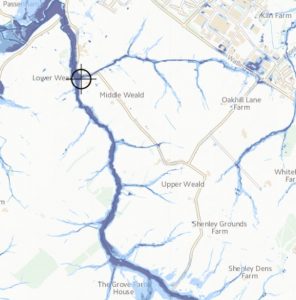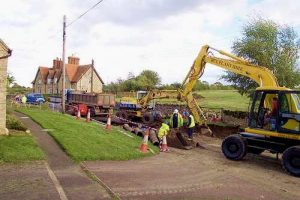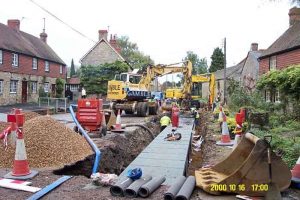Introduction

Geographically, Lower Weald (round marker) is located at the confluence of two water courses – the Whaddon and Kiln Farm brooks which combine to become the Calverton Brook which eventually drains into the River Ouse near Passenham, just south of Stony Stratford .
These brooks are not large but still have substantial catchment areas and are susceptible to flash flooding which is exacerbated if the surrounding fields are waterlogged or frozen. Flash flooding has also occurred in summer especially if the ground becomes baked hard during a drought followed by thunderstorms.
Before recent attenuation works, the Kiln Farm Brook entering the village from the East (right side of map) tended to rise first flooding out on to the Calverton Road due to the inadequate culvert size which carried the brook under the highway. The Whaddon Brook, flowing up from its much larger catchment area to the South, would then also rise and spill out on to the road at the corner of Lower Weald (shown by crosshairs) backing up against an undersized bridge and raised causeway which runs across the line of the watercourse.
The results of this flooding are nothing like we have seen elsewhere in the country due to changing weather patterns, but still very significant to the villagers who were affected at the time and have continuing house insurance implications. Here you will find the stories of the people affected including memories of past events and the heartfelt experiences of flooding in their own homes.
Individual Memories of Past Floods
1921 – Cecil West remembered No. 28 (Brook Cottage), flooding twice in three weeks.
1947 – He also recalled water reaching the doorstep of No. 21 where he was living at the time. This would indicate that Brook Cottage and Nos. 23, 24, 26 and 28 were probably affected.
Freda Rice remembered, as a child the family cottage No.31 across the Meadow, was flooded that year up to the top of the bottom step of the stairs. She still lives there but the cottage has not been flooded since. Freda also said that in those days the road between Old Pound Barn and Brook Cottage used to flood much more frequently than it does now after heavy rain.
Ella West recalled that sometimes the flood water from the Brook would rise up to Calverton Cottage garden fence, and once it came right up to the second bar of the gate into the Fountaines’ field opposite Manor Farm Cottages. She remembered also when Mrs. Welch and the Clark family lived in the cottages across the Meadow, water used to pour off the fields and gardens behind and flood the cottages, due to drain problems.

1965 – Brenda Toothill described a typical flood scene photographed from Rectory farm window, with a trusty Landrover preparing to pull a damp BMC Mini back out of the water while (she thinks) a young Tudor Cowley and Laurie Pell look on. (Historical note; George Cowley owned all the barns in the picture before they were converted – now Causeway House and Old Pound Barn. The building with the single upper storey window to rear of the large hay-barn gradually collapsed and is no longer there.)
1980 – 15 August, after a five-hour storm when 2½ inches of rain fell, was the last time that people of Lower Weald remember properties being flooded. Cecil West recalls the Taylor and Meakin’s homes (Nos. 24 and 26) being flooded then, the level ranging from 4 – 24 inches in some homes. Tony and Olga Bright were living at No. 29 Lower Weald then and remember 2 inches of water in their house that morning and trying to dry out the carpet before their daughter’s birthday party in the afternoon. In the road there was 3-4 feet of water; this had flooded their elderly Ford Cortina car up to the bottom of the steering wheel. Amazingly, when the waters subsided, the car started first time!
Pete Martin of No 18 recalls the 1980 flood. I moved into Lower Weald with my family in the summer of 1977 having done a lot of work on the house before moving in. Peter Luckett had caught me one day and in conversation said ‘you know it floods here?’ as he did with all prospective house buyers. I asked when it had last flooded. As the last time the houses had flooded seemed to be 1947 or 1948 I didn’t think any more about it as there had obviously been a lot of changes since then. I soon experienced the road flooding – the JCB digging out our run-in managed to sever the cable to the telephone box under water!
The night of 14th August 1980 was wild, windy and wet. I don’t think any of us had slept very well – we now had 3 children. At about 6am (Friday morning) – just light enough not to need the lights on I got up to get something for Tom (then 1) – and on opening the door at the foot of the stairs stepped off the bottom step into water swirling in under the front door. Leaving the kids upstairs Barbara and I moved as much stuff off the floor as we could, including propping furniture up on bricks. Luckily we had no carpets downstairs. I had laid cork tiles through the kitchen and living room (they have now survived over 20 years and 2 floods with only a few lifting). We tried everything we could to stem the flow of water – sandbags weren’t brought by the Council until later in the day – like nailing boards to the doorframe. But the water continued to rise. It eventually came in around the back as well, until it reached its maximum depth in the house of 9 inches (exactly the same as in 1998), just high enough to blow the electrics.
Friends from work, in Cofferidge Close, came out to help us get things out of the house. There was a great community spirit with people not flooded helping those that were. When it stopped raining things were put outside to dry – the railings on the corner had carpets over them for several days. The children, having got over the initial fear and trepidation had a very exciting day including, of course, getting very wet but it was August! The water receded during the afternoon and by the end of the day we were left with the layer of silt to clean up. Friends took things away to clean and dry – I had 150 soggy cardboard LP covers drying on the floor of Old Pound Barn.
In the aftermath there was much discussion about what measures should be taken – eventually some culverts were put through the causeway across the Calverton Place meadow to the right of the cottages. The level of the causeway is, I believe, exactly the same level as the water rose to in my house. I’ve not put a theodolite on it but that is where it dams. Don Meetens of 26 Lower Weald organised a flood warning sequence so that we could ring round and warn people if their houses were threatened, and regular work parties to clear the stream.
Laurian Taylor (nee Bull) then living at Brook Cottage (No. 28) also remembers the flood of August 15th 1980. It came without warning, usually. If heavy rain was anticipated, or the brook was high, we would prepare the house by placing sandbags over the outside air vents at ground level. I was woken by the voice of my mother stating in a matter of fact manner to my brother that “the furniture’s floating!” I shot out of bed, and rushed to the landing to discover that indeed the furniture was drifting around the ground floor, in thick, filthy, brown river water.
Distant cries of “are you alright in there?” could be heard coming from outside. When we looked through my bedroom window, Harry Beck was standing outside in his distinctive overalls and fishing waders, with an expression of concern, stating that he had tried to rouse us since the early hours of the morning. Our mother, being a very private person, and not wishing to be seen in public without her make up, assured Mr Beck that the family were fine, and that we could manage perfectly well without his assistance.
By this time the water had started to recede; this we later discovered was due to the opening of the floodgates near Stony Stratford. As my Wellington boots were conveniently upstairs, having tidied up the night before in preparation for visitors, I was nominated to go downstairs to assess the damage. It never crossed my mind that by entering the water I could have been electrocuted, as when my mother gave orders, you carried out her instructions without question. On stepping into the water, which was now around 3 feet deep, I could see from the tide marks, that the water had reached between 4 and 5 feet. The hall, living room, and dining room were unrecognisable, luckily the kitchen being on a higher level sustained only minor damage.
The fire brigade then arrived to pump the remaining water out of the house; this left an even worse mess, as duck feathers, tree branches, and silt covered everywhere. The stench of the river filled the house. It was at this point we realised that the house was in no state to receive visitors, and as all power and telephone lines were down, I had to walk to the telephone box in Calverton Road to cancel the visit. Our house was one of the worst affected, the flood reached from the bottom of our front garden, to the fields opposite, and around the corner near the water pump. This had been the worst flood since 1965, as flooding was a regular occurrence, often causing great annoyance to my parents, as drivers would still try to get their cars through the water, and would knock at the house for assistance when their vehicles broke down. I trust conditions have improved since then.

1985 – Outside Nos. 21-23 Lower Weald. In the latter half of the 80’s the water rarely rose much above the top step by the railings and only occasionally reached the front doorsteps of the cottages. The ferry passengers in the photo are Charlotte and Andrew Mitchell with Jonathan Muston about to disembark whilst Francesca holds the rope and concerned dad Dave Muston anticipates possible intervention.
1987 – The Louries moved into Causeway House and experienced their first main road flood in October, just before the hurricane force winds that devastated parts of southern England. Our daughter Sara and a friend sailed down the road in a rubber dinghy. We soon learned that the road flooded two or three times every year.
1990 – Black and white markers appeared along the stream by the road at the foot of the field called Causeway Piece, and a photo dated February of that year shows flood water two foot deep. In October of that year Milton Keynes was on red alert after 4 inches of rainfall in 3 days. Millfield, Stony Stratford was completely flooded, and the road through Passenham a raging torrent.
1992 – The road flooded at least three times, and in September the Milton Keynes Herald and Post reported Calverton as being ‘ imprisoned by floods as trenches failed to cope’.

1993 – On 14 October Milton Keynes Herald reports “Volkswagen in ditch during the floods at Lower Weald.”
There’s even a photo of the unfortunate vehicle and owner.
1996 – On 5 July, under the headline ‘Flooding cannot be stopped’, the Herald quotes from a new report issued by Milton Keynes Borough Council claiming that flooding in Lower Weald cannot be stopped completely but can be reduced. The Council had set aside £20,000 for replacement of the inadequate triple pipe culvert under the road in Lower Weald.
Flood alleviation works – October 2000
In November the brook between the River Great Ouse and the Old Wood yard was cleared by the Bucks Drainage Board with funding from the Council and the landowners. The last time this had been done was in 1981.

Eventually in October 2000 work began to improve the flow of the Kiln Farm Brook through Lower Weald by removing the inadequate triple pipes from under the road and replacing them by a much larger ‘box’ culvert similar to that shown in the picture on the right.

The original three small round pipes – visible in the centre of the picture left (to the the side of the contractors) were replaced by one large rectangular concrete box culvert similar to that seen in the picture (right) being installed nearer the centre of lower Weald. Here again inadequate small bore pipes were replaced by a much larger pre-cast concrete box culvert capable of taking much greater flood water flows.
Overall, the work took about a month to complete.
Further update
The issue of flood control higher up the Kiln Farm brook was finally addressed in 2015 with the building of a substantial dam and flood retention pond to the east of the village as part of the preparatory works for the new housing development on the west side of Milton Keynes. In dry periods the pond is normally empty other than for a small trickle of water from the original brook running across the bottom of it and then out under the retaining wall of the dam via 400mm diameter outlet pipe. However during periods of heavy rain, the pond has the capacity to hold back the flow and particularly the ever-increasing surface run-off from the roads, roofs and hard paved areas of the new Fairfield development which drains into the pond. This water is gradually released over a number of days via the single outlet pipe rather than rushing down through the village and flooding the road and low lying houses in Lower Weald as it used to.
In 2019 work is just beginning on a similar flood alleviation scheme for the catchment area of the Whaddon brook which will be taking the surface run-off from the other new major housing development of Whitehouse which is being built to the south of Calverton.